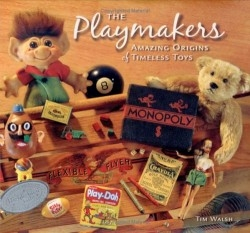It looks like you've stumbled upon a page meant to be read by our code instead of viewed directly. You're probably looking for this page.
The Playmakers
Amazing Origins of Timeless Toys
The things of childhood, particularly the playthings, remain in memory intimately associated with earliest pleasures. This new book for the nostalgic and trivia-minded-for any former child who from time to time thinks fondly of Cooties or Mr. Potato Head or Silly Putty-offers colorful profiles and background information on seventy-five of the most popular toys of the past century.
The author, who worked in the toy industry for fifteen years and is the inventor of two board games, has limited his book to discussions of toys invented by individual designers and not by teams employed by large toy companies. He goes so far as to say the book is about entrepreneurs. Readers might disagree, but will nevertheless find themselves entertained by the stories of how the toys were conceived, developed, and marketed. The book is brightened by more than 400 color photographs that make even the older toys look new, and by advertising reprints that evoke some of the initial frenzy surrounding such must-have toys as Barbie, Play-Doh, Slinky, Yahtzee, and Monopoly.
Monopoly is reported to have had its origins in The Landlord’s Game, which was created by a broadly gifted woman named Elizabeth Magie. Her 1904 patent application makes clear her purpose. “The object of the game,” she wrote, “is not only to afford amusement to the players, but to illustrate to them how the landlord has an advantage over other enterprises and also how the single tax would discourage land speculation.” As early as 1910, Walsh says, her game was being played on homemade boards on Eastern campuses, and an economics professor at Wharton was using it in his classes.
In keeping with his focus on entrepreneurs, Walsh identifies each toy’s predecessor (the toy that led directly to the development of the featured toy), the inventive idea (the person credited with the core concept), the inventor (the person most responsible for the toy’s creation), and the developer (who improved and/or popularized the toy), as well as describing other phases of each toy’s journey from conception to assembly line.
The subtitle promises “amazing origins of timeless toys,” but thrill-seekers will find little here to amaze them. The chief attraction of this book lies in what it appears to be at first glance-a brightly colored toy chest filled with memories and trivia.
Reviewed by
Harold Cordry
Disclosure: This article is not an endorsement, but a review. The publisher of this book provided free copies of the book to have their book reviewed by a professional reviewer. No fee was paid by the publisher for this review. Foreword Reviews only recommends books that we love. Foreword Magazine, Inc. is disclosing this in accordance with the Federal Trade Commission’s 16 CFR, Part 255.
